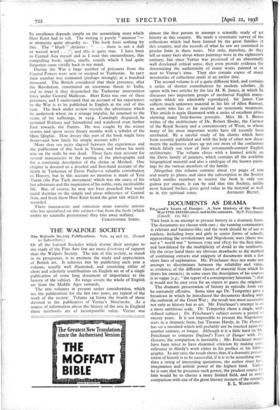THE WALPOLE SOCIETY
The Walpole Society Publications. Vols. 24 and 25. (Issued to Subscribers.)
OF all the learned Societies which devote their energies to the study of the Fine Arts few are more d esirving of support than the Walpole Society. The aim of this society, as stated in its prospectus, is to promote the study and appreciation of British art. It achieves this by publishing each year a volume, usually well illustrated, and consisting either of short and scholarly contributions on English art or of a single publication of some long document of importance to the history of the subject. Its range covers the whole of English art from the Middle Ages onwards.
The two volumes at present under consideration, which are the publications for the last two years, are typical of the work of the society. Volume 24 forms the fourth of those devoted to the publication of Vertue's Notebooks. As a source of information about the history of the arts in England these notebooks are of incomparable value. Vertue was
almost the first person to attempt a scientific study of art history in this country. He made a systematic survey of the collections which had been formed by the great families of this country, and the records of what he saw are contained in precise form in these notes. Not only, thereforg, do they tell us many facts about where paintings were in the eighteenth century, but since Vertue was possessed of an abnormally well developed critical sense, they even provide evidence for determining the authenticity of many works painted at or near to Vertue's 'time. They also contain copies of many inventories of collections made at an earlier date.
The second volume is of a quite different kind, and contains a series of shorter contributions by modem scholars. At opens with two articles by the late M. R. James, in which te discusses two important groups of mediaeval English manur scripts which are admirably reproduced. Sir James - Caw collects much unknown material in his life of Allen Ramsay, an artist who has so far received no systematic treatment. This article is again illustrated with a series of excellent plates showing many little-known portraits. Miss M. I. Batten writes of the architecture of Dr. Robert Hooke, the Curator of the Royal Society and a contemporary of Wren, to whom many of his most important works have till recently been attributed. By a careful study of his diaries which have been recently published and with the help of other new docu- ments the authoress clears up yet one more of the confusions which falsify our view of later seventeenth-century English architecture. The volume closes with a learned article on the Devis family of painters, which contains all the available biographical material and also a catalogue of the known paint- ings by the various members of the family.
Altogether this volume contains about 170 pages of text and nearly so plates, and since the subscription to the Society which entitles members to receive the book is only one guinea per annum, it can be said that this Society, unlike most learned bodies, gives good value in the material as well










































 Previous page
Previous page